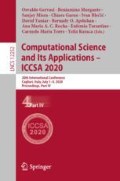Abstract
Different spatial patterns of urban growth exist such as infill, edge-expansion and leapfrog development. This paper presents a methodology, and a corresponding script, that classify new residential buildings as patterns of urban growth. The script performs a combination of variography and morphometry over building centroids on two different dates. The test data is made of the building centroids of 2002 and 2017 for Centre-Var, a region located in southern France. The different bounding regions, yield from series of morphological closings, allow classifying the building centroids that appeared between 2002 and 2017 into different categories of spatial patterns of urban growth. The final classification is made according to the degree of clustering/scattering of new centroids and to their locations regarding existing urban areas. Preliminary results show that this protocol is able to provide useful insights regarding the degree of contribution of each new residential building to the following patterns of urban growth: clustered infill, scattered infill, clustered edge-expansion, scattered edge-expansion, clustered leapfrog and scattered leapfrog. Open access to the script and to the test region data is provided.
Access this chapter
Tax calculation will be finalised at checkout
Purchases are for personal use only
Notes
- 1.
French national institute for statistical and economic studies.
References
United Nations: Transforming our World: The 2030 Agenda for Sustainable Development. United Nations, New York (2015)
European Environment Agency. Urban sprawl in Europe, The ignored challenge. European Commission report, p. 60 (2006)
Verderber, S.: Sprawling Cities and Our Endangered Public Health. Routledge, London (2012)
Brueckner, J.K.: Urban sprawl: diagnosis and remedies. Int. Reg. Sci. Rev. 23(2), 160–171 (2000)
Bhatta, B., Saraswati, S., Bandyopadhyay, D.: Urban sprawl measurement from remote sensing data. Appl. Geogr. 30(4), 731–740 (2010)
Galster, G., Hanson, R., Ratcliffe, M., Wolman, H., Coleman, S., Freihage, J.: Wrestling sprawl to the ground: defining and measuring an elusive concept. Hous. Policy Debate 12(4), 681–717 (2001)
Bhatta, B.: Analysis of Urban Growth and Sprawl from Remote Sensing Data. Advances in Geographic Information Science, p. 172. Springer, Berlin (2010). https://doi.org/10.1007/978-3-642-05299-6
Smith, N.: The New Urban Frontier, Gentrification and the Revanchist City. Routledge, New York (1996)
Liu, Z., He, C., Wu, J.: General spatiotemporal patterns of urbanization: an examination of 16 world cities. Sustainability 8, 41 (2016)
Jenks, M., Burton, E., Williams, K.: The Compact City: A Sustainable Urban Form? Spon Press, London, p. 360 (1996)
Burdett, R., Philipp, R.: Shaping Cities in an Urban Age, p. 448. Phaidon Press, New York (2018)
Tannier, C., Thomas, I., Vuidel, G., Frankhauser, P.: A fractal approach to identifying urban boundaries. Geogr. Anal. 43(2), 211–227 (2011)
Chaudhry, O., Mackaness, W.A.: Automatic identification of urban settlement boundaries for multiple representation databases. Comput. Environ. Urban Syst. 32(2), 95–109 (2008)
Perez, J., Fusco, G., Moriconi-Ebrard, F.: Identification and quantification of urban space in India: defining urban macro-structures. Urban Stud. 56(10), 1988–2004 (2019)
Usui, H.: A bottom-up approach for delineating urban areas minimizing the connection cost of built clusters: comparison with top-down-based densely inhabited districts. Comput. Environ. Urban Syst. 77, 101363 (2019)
Pebesma, E.: Multivariable geostatistics in S: the GSTAT package. Comput. Geosci. 30, 683–691 (2004)
Armstrong, M.: Experimental variograms. In: Basic Linear Geostatistics, pp. 47–58. Springer, Berlin, Heidelberg (1998). https://doi.org/10.1007/978-3-642-58727-6_4
Dauphiné, A., Voiron Canicio, C.: Variogrammes et structures spatiales, Collection Reclus Modes d’Emploi no 12, GIP Reclus (1988)
Mills, D.E.: Growth, speculation and sprawl in a monocentric city. J. Urban Econ. 10(2), 201–226 (1981)
Zang, W., Wrenn, D.H., Irwin, E.G.: Spatial heterogeneity, accessibility, and zoning: an empirical investigation of leapfrog development. J. Econ. Geogr. 17(3), 547–570 (2017)
Author information
Authors and Affiliations
Corresponding author
Editor information
Editors and Affiliations
Appendix: Data and Script
Appendix: Data and Script
Files
- CV_PT_Ext_0217.gpkg (9.8 MB)
- PT_Classification (v.1.2 - 13.6 kB)
- CV_PT_Ext_0217_RES.gpkg (48.9 MB)
- README.txt (2.9 kB)
Title
Variography and Morphometry for Classifying Building Centroids as Patterns of Urban Growth v1.2
Link
https://zenodo.org/record/3899981
Description
This upload contains a dataset ready to be processed, an R script (v1.2) and a dataset with the associated results of the processing steps. The dataset is a GeoPackage file (EPSG:2154 - RGF93/Lambert-93 - Projected) named “CV_PT_Ext_0217.gpkg” containing two layers (1) “CV_Building_PT”: a point feature class made of the centroids of residential buildings in 2002 and 2017 extracted from the French BD TOPO® (National Geographic Institute). This layer possesses two attribute columns indicative of the building presence for each period: “Pres_2002” and “Pres_2017” (modalities: “1” for building presence; “0” otherwise). (2) “Centre_Var_ext”: a polygon feature class related to the extent of the case study: a region in southern France named Centre-Var. The script performs a combination of variography analysis and morphological closings over the building centroids. The different bounding regions then allow classifying new residential buildings (the ones that appeared between 2002 and 2017) into different categories of patterns of urban growth according to their degrees of clustering/scattering and to their locations regarding existing urban areas. The GeoPackage associated with the results “CV_PT_Ext_0217_RES.gpkg” contains two additional layers (3) “PT_CLASS” a point feature class made of the new building centroids with an attribute column “cat” related to the classification outputs. The categories are as follows: 1 - clustered infill, 2 - scattered infill, 3 - clustered edge-expansion, 4 - scattered edge-expansion, 5 - clustered leapfrog and 6 - scattered leapfrog. (4) “BR_Clipping”: a polygon feature class made of the different bounding regions clipped together.
Rights and permissions
Copyright information
© 2020 Springer Nature Switzerland AG
About this paper
Cite this paper
Perez, J., Ornon, A., Usui, H. (2020). Variography and Morphometry for Classifying Building Centroids: Protocol, Data and Script. In: Gervasi, O., et al. Computational Science and Its Applications – ICCSA 2020. ICCSA 2020. Lecture Notes in Computer Science(), vol 12252. Springer, Cham. https://doi.org/10.1007/978-3-030-58811-3_30
Download citation
DOI: https://doi.org/10.1007/978-3-030-58811-3_30
Published:
Publisher Name: Springer, Cham
Print ISBN: 978-3-030-58810-6
Online ISBN: 978-3-030-58811-3
eBook Packages: Computer ScienceComputer Science (R0)

